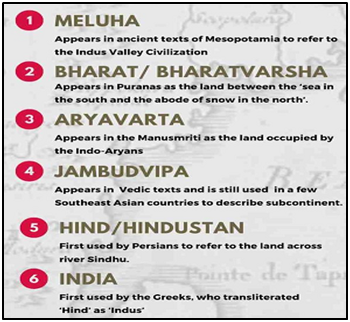Why in News?
- Opposition politicians have been posting images of an official invitation to a G20 dinner hosted by “The President of Bharat” instead of the usual “President of India”.
- There is speculation of an official change in the name of the country from India to Bharat, even though Article 1 of the Constitution uses the two names interchangeably: “India, that is Bharat, shall be a Union of States.”
What’s in Today’s Article?
- A Short History of the Nation’s Names
- How did ‘Bharat’ and ‘India’ Come into the Constitution of India?
- Recent Attempts of Name Change of the Nation
A Short History of the Nation’s Names:

- Bharat:
- The roots of “Bharat”, “Bharata”, or “Bharatvarsha” are traced back to Puranic literature, and to the epic Mahabharata.
- The Puranas describe Bharata as the land between the sea in the south and the abode of snow in the north.
- Social scientists explained Bharata/ the remote past in the sense of a religious and socio-cultural entity [A unity of a common faith and culture - Jawaharlal Nehru], rather than a political or geographical one.
- ‘Bharata’ refers to the subcontinental territory where the Brahmanical system of society prevails.
- Bharata is also the name of the ancient king of legend who was the ancestor of the Rig Vedic tribe of the Bharatas, and by extension, the progenitor of all peoples of the subcontinent.
- Hindustan:
- The name Hindustan is thought to have derived from ‘Hindu’, the Persian equivalent form of the Sanskrit ‘Sindhu’ (Indus), which came into currency with the Persian conquest of the Indus valley that began in the 6th century BC.
- By the time of the early Mughals (16th century), the name ‘Hindustan’ was used to describe the entire Indo-Gangetic plain.
- In the mid-to-late eighteenth century, Hindustan often referred to the territories of the Mughal emperor, which comprised much of South Asia.
- India:
- The Greeks used ‘Indus’ in place of ‘Sindhu/Hindu’. By the time the Macedonian king Alexander invaded India in the 3rd century BC, ‘India’ had come to be identified with the region beyond the Indus.
- From the late 18th century onwards, British maps increasingly began to use the name ‘India’, and ‘Hindustan’ started to lose its association with all of South Asia.
- Part of the appeal of the term India may have been its Graeco-Roman associations, its long history of use in Europe, and its adoption by scientific and bureaucratic organisations such as the Survey of India.
- The adoption of India suggests how colonial nomenclature helped to usher in an understanding of the subcontinent as a single, bounded and British political territory.
How did ‘Bharat’ and ‘India’ Come into the Constitution of India?
- In his ‘Discovery of India’, Nehru referred to “India”, “Bharata” and “Hindustan”, but when the question of naming India in the Constitution arose, ‘Hindustan’ was dropped and both ‘Bharat’ and ‘India’ were retained.
- During the Constituent Assembly debates the “Name and territory of the Union” was taken up for discussion on September 17, 1949.
- Right from the time Article 1 was read out as “India, that is Bharat, shall be a Union of States”, a division arose among the members.
- There were quite a few members who were against the use of the name ‘India’, which they saw as being a reminder of the colonial past.
- HV Kamath suggested that the first article should read, “Bharat, or in the English language, India, shall be…”.
- Hargovind Pant, who represented the hill districts of the United Provinces, made it clear that the people of Northern India “wanted Bharatvarsha and nothing else”.
- None of the suggestions were accepted, illustrating contrasting visions of the budding nation.
- The draft Article 1 of the Constitution - “India, that is Bharat, shall be a Union of States” - was adopted by the Constituent Assembly on September 18, 1949.
- The five-day special session of Parliament starts on September 18, 2023, and this fuelled speculation of an official change in the name of the country from India to Bharat, especially among Opposition parties.
Recent Attempts of Name Change of the Nation:
- In 2020, the Supreme Court had dismissed a PIL seeking to remove “India” from the Constitution and retain only Bharat in order to ensure the citizens of this country get over the colonial past.
- The apex court held that “India is already called Bharat in the Constitution itself.”
- In his Independence Day address (2022), the Indian PM had spoken about the “Panch Pran”, stressing the need to decolonise minds and taking pride in India’s civilisational heritage.
- A government booklet on the Indian PM’s upcoming visit to Indonesia for the 20th ASEAN-India Summit and the 18th East Asia Summit referred to him as the “Prime Minister of Bharat”.









